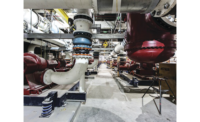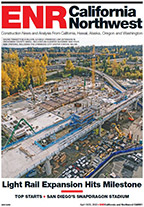Condos have staged a comeback. The multifamily and hospitality sector achieved a major turnaround in 2012, placing 10 projects, totaling nearly $2.4 billion, on ENR California's Top Starts list. In 2011, only two $100-million-plus projects in that segment got under way. In 2010, there were none.
The $800-million Graton Resort and Casino was the largest hospitality project to break ground last year. Located about 50 miles north of San Francisco, the project's total cost includes a multistory hotel in a planned later phase. During the resort's rapid construction schedule of less than 18 months, Sylmar-based Tutor Perini Corp. will install 3,100 tons of steel, 14,000 cu yd of concrete and 975,000 sq ft of drywall.
Condo and apartment projects were especially prevalent in Southern California, including the $350-million Village at Santa Monica, which will have 158 luxury condos, 160 affordable residences and retail space.
"New starts in multifamily housing hit the bottom in 2011, and we are starting to see it come back," says Judy Caruthers, executive vice president with commercial real estate firm Jones Lang LaSalle, Los Angeles. Vacancy rates have remained low in the past several years, but Caruthers says the popularity of an urban lifestyle is prompting the construction of hip loft projects. They include the $190-million Blvd 6200 in Hollywood and the two high-rise towers that constitute the $169-million Vermont, located along Wilshire Boulevard in Los Angeles.
Other strong sectors on the starts list include transportation, with nine new light rail or highway projects totaling nearly $3 billion, and health care, with four major hospital starts for a total of $1.2 billion.
Two Bay Area Rapid Transit District projects got under way in 2012. A $772-million contract for the first phase of the Silicon Valley Berryessa Extension was awarded to a joint venture led by Skanska USA Civil's Oakland office. The 16-mile rail line will cost $2.3 billion after all contracts are let. It will connect to the Warm Springs Extension in Fremont. Construction on that spur started in 2009 and its $299.1-million contract was awarded in 2012 to a Kiewit/Mass joint venture that will construct the line, track, stations and systems inside previously built subway tunnels.
Skanska's Riverside office is constructing the $541.7-million Expo Phase II Light Rail project, which will extend the Los Angeles light rail system 6.6 miles into Santa Monica. Expo II and the Berryessa extension are examples of California residents' commitment to transit, says Mike Aparicio, Skanska executive vice president. "Both projects traverse multiple urban communities and feature hundreds of stakeholder agencies," he adds.
With an initial $6 billion in contracts for high-speed intercity rail looming on the horizon, the rail construction sector shows promise, Aparicio says. "The outlook for transit work in California is probably the envy of the rest of the country," he adds. "With such a well-funded program, we're going to see years of work ahead."


















Post a comment to this article
Report Abusive Comment